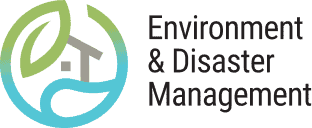Key environmental issues and/or intervention points addressed in GRRT training included:
1. Construction and site selection of temporary and permanent shelters
Unintended consequences arose from both the general site selection and the individual housing communities designed for temporary reconstruction housing.
In some housing communities there were two environmental problems that occurred. Firstly, the prefabricated homes, Mediaguas, provided to displaced persons were typically altered and expanded by the occupants using reclaimed wood from destroyed homes. Secondly, reclaimed wood was also used for fuel in wood-burning stoves. The access to reclaimed wood resources created both a fire hazard in the Aldeas, housing communities, and an increased reliance on timber products from an area which cannot support sustainable timber harvesting. To reduce the risk of fire, fire protection services were instituted in the communities such as fire equipment, safety education, and inspections.
The general site selection led to environmental problems because the sites were located on hillsides and during construction the vegetation was cleared and never replaced. As a result, the community was vulnerable to an increased risk of erosion and flooding which could occur during rains, lowering the quality of life for residents and potentially washing out roads or doing damage to houses or possessions stored beside homes. To mitigate this potential impact drainage channels should have been incorporated along with increased vegetation and gardens on the site.
2. Debris and Sewage Management
Debris from the disaster led to numerous problems with disposal. Massive amounts of debris from destroyed homes included wood, broken pieces of concrete, bricks, asbestos roofing, scrap metal, plastics, trash and other materials. One particular problem, in Concepcion, was that damaged large multi-story buildings had to be “deconstructed” leading to the creation of more waste. Debris was also dumped in ecologically fragile wetland areas, and in some cases bulldozed back into the sand of the beach. These did not serve as permanent solutions because rainy season flooding could relocate debris, in addition to wind and waves on the beaches, which could mean repetition of disposal operations. To reduce the amount of waste and debris needing disposal much more of the debris could have been re-used or recycled using a debris sorting and crushing machine to process unconsolidated materials.
3. Contamination of Drinking Water
Another problem found in multiple locations was the contamination of rivers and ocean water from sewage treatment plants that had been damaged during the earthquake. The problem was experienced in both small towns and urban areas. At least four major sewage treatment plants had broken open during the quake and released thousands of cubic meters of unprocessed sewage into the Biobio River. Additionally, well water was impacted by the earthquake. Until the treatment plants were fully repaired they could only operate at partial capacity and treat a small portion of the waste water. The result was that faulty sewage treatment on the coast further threatened the health of ocean fisheries and sea grass beds that form the basis of many people’s livelihoods. Prior to the disaster large scale sewage treatment had been a problem, so reconstruction efforts that would improve sewage treatment provided an opportunity to build the community back in a way that was safer and more sustainable than before.
4. Livelihoods
The environmental impacts of the disaster affected the livelihoods of those that depended on marine resources such as fisherman and sea grass harvesters. The earthquake impacted the shoreline, ocean floor and the mouths of rivers. Geophysical changes included the raising or subsidence, dropping, of the land from the earthquake. These changes to the landscape, particularly the shifting of sands and rocks in the mouth of rivers, made fishing more hazardous and limited access of certain areas to fisherman. Changes to the ocean floor also impacted shellfish and sea grass, in some areas such as Tirua, many of the grass beds had disappeared either having been buried in sand or uprooted. These changes had a devastating impact on the sea grass harvesters. As a result of the lost harvest and uncertainty about future crops many of the harvesters began turning to alternative revenue sources. For example, in Tirua some residents had switched to timber harvesting, an industry with little management in place, which created a risk of over exploitation of forest resources and potential conflict with nearby timber company plantations.
This is one example of how limited livelihood options can force disaster survivors to switch to other less well managed industries. To help address and anticipate the loss of some livelihoods a re-assessment of marine resources could help ensure that exploitation plans reflected better management practices and the reality of the limits of the natural resource base.
